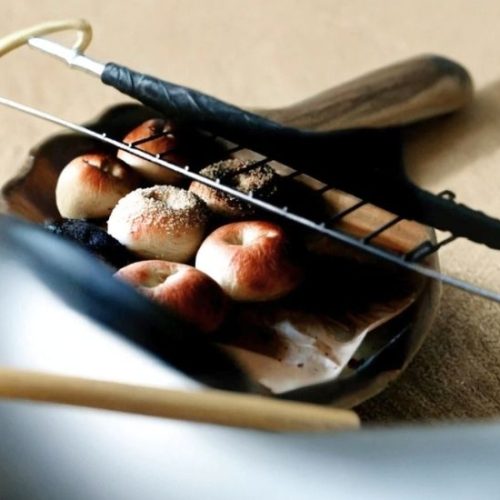
Bagels
Classic New York-Style Bagels made the traditional way with a boil-before-bake technique. This recipe yields chewy, golden bagels with a shiny crust and soft interior, ready in about 2 hours including rising time.
Equipment
- Large bowl (1)
- Measuring cups and spoons
- Stand mixer with dough hook (optional but recommended)
- Large heavy-bottomed pot (1)
- Slotted spoon or skimmer (1)
- Baking sheet (1)
- Parchment paper or oil for baking sheet
- Wire cooling rack (1)
- Kitchen towel for covering dough
Ingredients
- 2 teaspoons active dry yeast
- 4 ½ teaspoons granulated sugar
- 1 ¼ cups warm water approximately 105°F / 40°C; may need up to ¼ cup more
- 3 ½ cups bread flour or high-gluten flour about 440 g; extra flour for kneading
- 1 ½ teaspoons fine salt
- Optional toppings: caraway seeds coarse salt, poppy seeds, sesame seeds, minced fresh garlic, minced onion, cinnamon sugar, or everything bagel seasoning
- Oil for coating the bowl and baking sheet
Instructions
- Activate the Yeast: In a small bowl or measuring cup, combine ½ cup of the warm water with the sugar and yeast. Let the mixture rest untouched for 5 minutes until it becomes foamy. Then gently stir to fully dissolve the sugar and yeast.
- Combine Dry Ingredients: In a large mixing bowl, whisk together the bread flour and salt until evenly distributed. Create a well in the center of the flour mixture to hold the liquid ingredients.
- Form the Dough: Pour the activated yeast mixture into the well. Add about one-third of the remaining warm water to the flour. Gradually stir, incorporating the flour from the edges into the liquid. Continue adding the rest of the water slowly, adjusting as needed to create a moist but firm dough. The dough should feel slightly tacky but not sticky.
- Knead the Dough: Transfer the dough onto a lightly floured surface. Knead for 8 to 10 minutes, working in extra flour as necessary, until the dough becomes smooth, elastic, and slightly stiff. This development is key for a chewy bagel texture.
- First Rise: Lightly grease a large bowl with oil and place the dough inside, turning it to coat all sides. Cover the bowl with a damp kitchen towel or plastic wrap. Set it in a warm, draft-free spot to rise until the dough doubles in volume, about 1 hour.
- Shape the Bagels: After rising, gently deflate the dough and let it rest for 10 minutes. Divide the dough into eight equal pieces. Roll each piece into a smooth ball by cupping your hand over it and moving it in a circular motion on the work surface. To form bagels, press a floured finger through the center of each ball to create a hole, then gently stretch the hole to about one-third the bagel’s diameter. Place the shaped bagels on a greased or parchment-lined baking sheet.
- Rest Before Boiling: Cover the bagels loosely with a damp cloth and let them rest for 10 minutes while you preheat the oven to 425°F (220°C).
- Boil the Bagels: Bring a large pot of water to a rolling boil, then reduce to a simmer. Using a slotted spoon, carefully lower a few bagels at a time into the water. Boil for 1 minute on one side, then flip and boil for an additional minute. For a chewier bagel closer to authentic New York style, boil for 2 minutes per side.
- Add Toppings: If desired, immediately after boiling, brush the bagels with an egg wash or water and sprinkle your choice of toppings to adhere.
- Bake to Perfection: Transfer the boiled and topped bagels back to the prepared baking sheet. Bake in the preheated oven for 20–25 minutes, or until they develop a deep golden brown color and a glossy crust.
- Cool and Enjoy: Remove bagels from the oven and transfer to a wire rack to cool slightly before slicing and serving. Enjoy with cream cheese, butter, or your favorite spreads.
Notes
- Water Quantity Flexibility: Depending on your local humidity and flour type, you may need to adjust the water slightly to achieve the right dough consistency. The dough should be moist and firm, not dry or crumbly.
- Flour Type: Bread flour or high-gluten flour is recommended for that signature chewy texture. All-purpose flour may yield softer bagels but can be used if needed.
- Boiling Time: Extending the boil to 2 minutes per side enhances chewiness and gives the bagels a more authentic crust, though 1 minute per side works well for softer results.
- Toppings: Feel free to experiment with classic or creative toppings. Use an egg wash (beaten egg with a tablespoon of water) to help seeds and spices stick better if desired.
- Storage: Store bagels in an airtight container at room temperature for up to 2 days or freeze for longer storage. Reheat by toasting or warming in the oven for best texture.